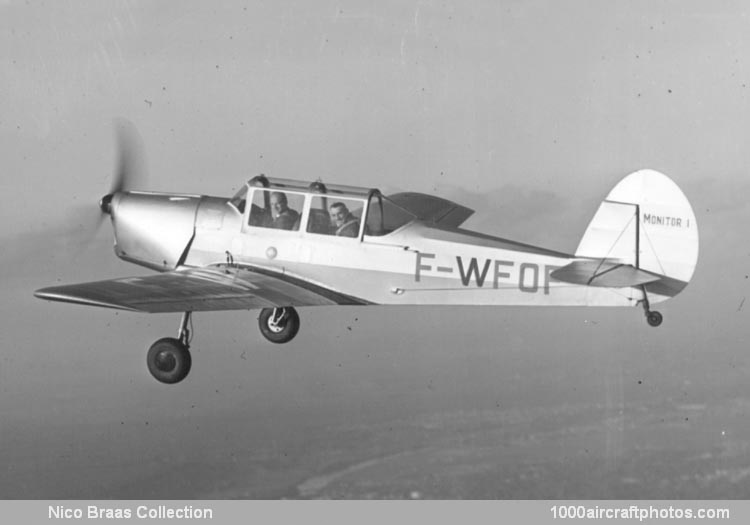04/30/2014. Remarks by Walter van Tilborg and Luc Wittemans: "The Monitor was the last aircraft type that was built under the banner of SA des Usines Farman. It started life as a low wing monoplane development of the Belgian Stampe-Vertongen SV.4 biplane, which had been produced by Farman under license before WW II, hence there were close ties with Belgium. The Monitor was designed as SR.7 and SR.8 by Constructions Aéronautiques Stampe et Renard SA, a Belgian company founded in 1947 by Jean Stampe and Alfred Renard.
Development of the SR.7 Monitor I started in 1951 and the basic all-wood fuselage and landing gear of the SV.4B were used. The aircraft was built by Stampe et Renard in Belgium and the fuselage, wings and tail surfaces were transferred by road to Farman for completion in June 1952. Power plant was an 140 hp Renault 4Pei Bengali four-cylinder air-cooled inverted in-line engine. Redesignated Farman F.500 Monitor I, the aircraft received the test registration F-WFOF and first flew on July 11, 1952. Subsequently the aircraft was also evaluated by the l'Armée de l'Air (French AF).
The F.500 was re-engined with an 170 hp Régnier 4L.02 four-cylinder air-cooled inverted in-line engine and redesignated F.520 (still called Monitor I), it was first flown in that form on June 15 1953. After gaining a CofA the registration was changed to F-BFOF on July 11, 1952.
The SR.7B Monitor III was again built in Belgium before transfer to Farman for completion in June 1954. This aircraft used the wooden wings of the Monitor I which were mated to a new all-metal fuselage, the power plant was an 170 hp Régnier 4L.02 engine. Redesignated Farman F.521 Monitor III, the aircraft received the test registration F-WGVQ and first flew on July 21, 1954.
A second SR.7B Monitor III was built by Stampe et Renard in Belgium and this machine was entered into the Belgian register as OO-SRZ on April 7, 1954. Construction-wise this second SR.7B was very similar to the Farman F.521 Monitor III, but it had a small dorsal fairing ahead of the fin and a different make engine, an 180 hp Blackburn Cirrus Bombardier 702. The SR.7B was seen as potential successor for the Belgian AF's SV.4, but no orders were placed. The aircraft was later used for aerobatic and air show work and was often flown by the famous pilot Léon Biancotto. The SR.7B was damaged in a mishap in 1960, but was repaired and later joined the collection of the Brussels Air Museum.
The final aircraft to fly was built in France by Farman and designated F.510 Monitor II (designed as the SR.8 Monitor II). It was developed at the request of the SALS and featured an all-metal construction, including the wings, and was powered by a 260 hp Salmson-Argus 8A5-04 eight-cylinder air-cooled inverted V-engine. This final aircraft made its maiden flight on August 5, 1955, and was also evaluated by the l'Armée de l'Air against the Nord N-3200 as a possible trainer, but lost out to the Nord design.
